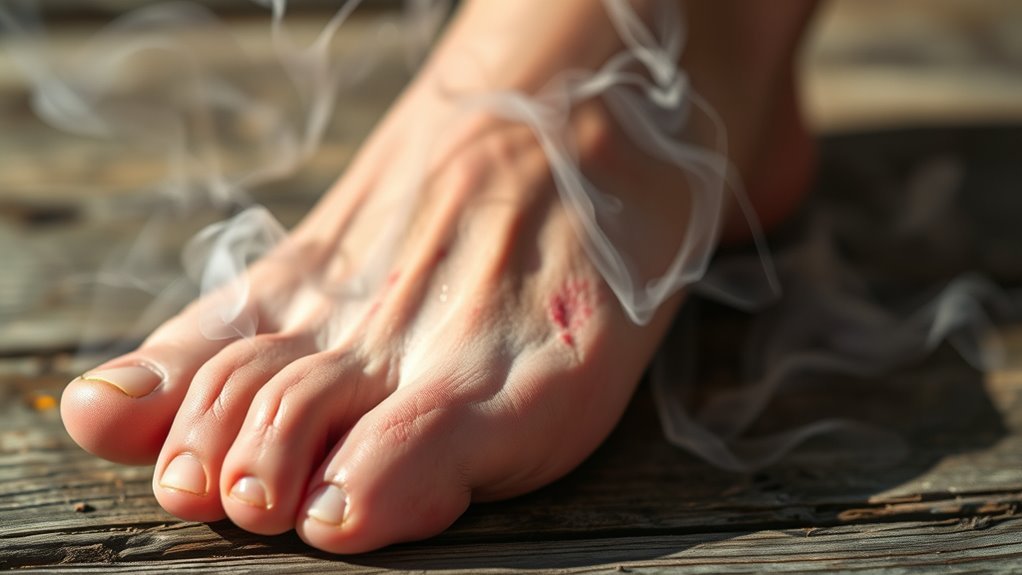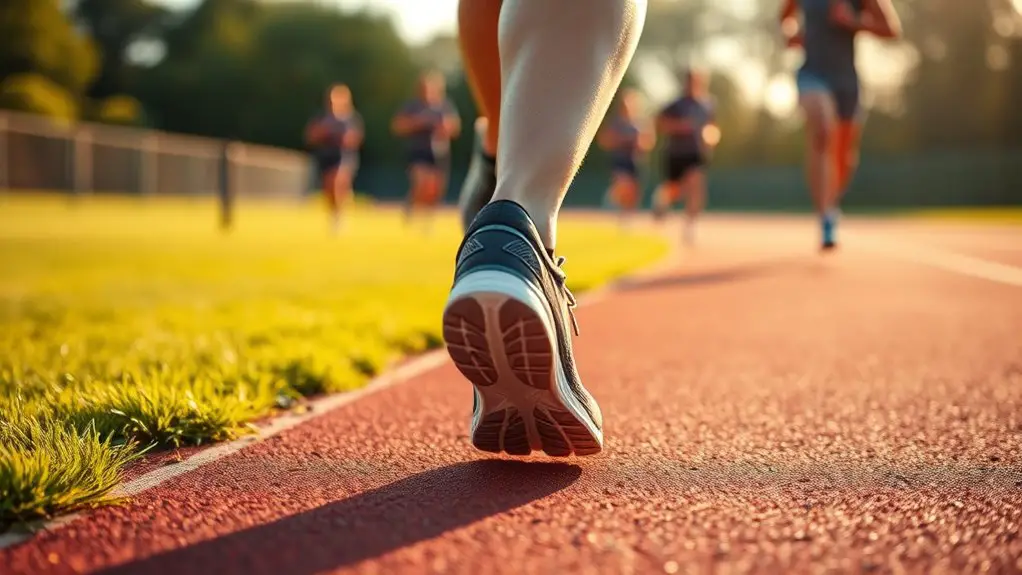Yes, athlete’s foot can smell. The fungal infection creates a warm, moist environment that encourages bacteria growth, leading to unpleasant odors. Sweat and dead skin cells contribute to bacterial proliferation, especially in tight, non-breathable shoes. To manage the smell, it’s essential to keep your feet dry and clean, use antifungal powders, and choose breathable footwear. If you’re curious about further ways to manage symptoms effectively, there are more tips you might find helpful.
Understanding Athlete’s Foot and Its Causes
Although athlete’s foot is often associated with itching and discomfort, it is crucial to understand what causes this common fungal infection. Primarily, it stems from a type of fungus that thrives in warm, moist environments, like locker rooms or sweaty shoes. When you walk barefoot in such areas or wear damp footwear, you increase your risk of exposure. To prevent athlete’s foot, keep your feet clean and dry, opting for breathable footwear and moisture-wicking socks. Regularly changing your socks and avoiding sharing personal items, like towels or shoes, can further shield you from this pesky infection. Embracing these simple habits not only enhances your foot health but also allows you the freedom to enjoy life without the nagging irritation of athlete’s foot.
The Connection Between Fungal Infections and Odor
When dealing with fungal infections like athlete’s foot, you might notice an unpleasant odor accompanying the symptoms. This odor is often caused by the breakdown of skin cells and the presence of bacteria, which thrive in the warm, moist environment that fungal infections create.
To tackle the issue effectively, consider these odor prevention tips:
- Keep your feet dry and clean to minimize moisture.
- Use antifungal powders or sprays, as they can help reduce both fungal growth and odor.
- Rotate your footwear to allow shoes to air out and prevent a buildup of bacteria.
Factors That Contribute to Foot Odor
Foot odor can be influenced by several factors, many of which are exacerbated by conditions like athlete’s foot. Your feet have a high concentration of sweat glands, which can produce moisture, creating the perfect environment for bacteria to thrive. When sweat mixes with dead skin cells, it fuels bacterial growth, leading to unpleasant smells. Additionally, wearing tight or non-breathable shoes can trap heat and moisture, worsening the situation. If you’ve got fungal infections, they can also contribute to odor, as they often encourage more bacteria to flourish. Ultimately, keeping your feet dry and clean is essential in minimizing foot odor and reclaiming your freedom to feel comfortable in any shoes you choose.
Managing Symptoms and Reducing Smell
Even if you’re dealing with athlete’s foot, there are effective ways to manage symptoms and reduce the smell. You can regain your confidence and comfort with a few simple strategies. Focus on symptom relief and odor control with these tips:
- Keep your feet dry: Moisture promotes fungal growth, so dry your feet thoroughly after washing.
- Use antifungal powders: These can help absorb moisture and provide odor control throughout the day.
- Choose breathable footwear: Opt for shoes made of natural materials to allow air circulation and reduce sweat.
When to Seek Medical Attention
If your athlete’s foot symptoms persist despite home treatment, it’s time to consult a healthcare professional. You shouldn’t have to endure discomfort, and knowing when to seek help is essential. If you notice an increase in symptom severity—like intense itching, redness, or swelling—don’t hesitate. Also, if you see blisters or notice any signs of infection, it’s a clear signal that you need medical attention. A healthcare provider can offer effective treatment options tailored to your specific situation, which might include prescription antifungals or advice on managing your condition. Remember, your health and comfort are paramount, so don’t wait too long if your symptoms aren’t improving. Taking action is the first step toward regaining your freedom from athlete’s foot.
Frequently Asked Questions
Can Athlete’s Foot Spread to Other Parts of My Body?
Yes, athlete’s foot can spread to other parts of your body, almost like an unwelcome guest that won’t leave. This fungal infection can transfer through direct contact or by using contaminated items. It’s essential to practice proper athlete’s foot transmission prevention, like keeping your feet dry and wearing breathable shoes. By maintaining good hygiene and avoiding shared towels or shoes, you can protect yourself and embrace the freedom of healthy, happy feet.
Is Athlete’s Foot Contagious to Other People?
Yes, athlete’s foot is contagious to other people. It can spread through direct contact with an infected person or indirectly through contaminated surfaces, like floors or towels. To minimize athlete’s foot transmission, practice good hygiene, wear sandals in communal areas, and avoid sharing personal items. Keeping your feet dry and clean is key for fungal infection prevention. Remember, staying proactive helps you enjoy freedom without the worry of passing on this pesky condition!
Can Athlete’s Foot Cause Blisters or Sores?
Yes, athlete’s foot can lead to blister formation and sore development. Imagine the discomfort creeping in, your skin feeling tighter and more irritated. As the infection progresses, you might notice painful blisters popping up between your toes or on the soles of your feet. These sores can become quite bothersome if left untreated. It’s crucial to take action quickly, so you can regain your freedom and enjoy comfortable, healthy feet once again.
Does Athlete’s Foot Affect Only Athletes?
No, athlete’s foot doesn’t just affect athletes. Anyone can get this fungal infection, especially if they’re in damp environments or wear tight shoes. You’re at risk if you walk barefoot in public places like pools or gyms. So, don’t think you’re immune just because you’re not an athlete. Taking care of your feet and maintaining good hygiene can help keep that pesky infection at bay, giving you the freedom to enjoy activities worry-free.
How Long Does It Take to Treat Athlete’s Foot?
You might be wondering how long it’ll take to kick athlete’s foot to the curb. Well, with effective remedies, you’re looking at about two to four weeks for treatment duration. But hold on—don’t rush! Sticking to antifungal creams or powders consistently is key. If you’re diligent, you’ll feel that freedom from itching and discomfort sooner than you think. Just remember, patience is part of the journey to healthier feet!




